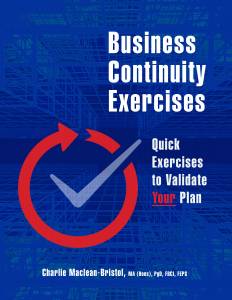Coordinating Emergency Response and Business Continuity in Manufacturing
Charlie Maclean-Bristol discusses the different emergency response and business continuity issues to consider after an incident and how both teams can communicate efficiently.
I have been working with two manufacturing companies that both supply products to the construction industry. I have worked for several manufacturing organizations and have always had to work hard to ensure that the principles of business continuity work in a manufacturing environment. I thought I would discuss some ideas to ensure the integration of emergency response and business continuity, preventing incidents where two different plans are invoked simultaneously, with separate incident management teams trying to handle the same situation, leading to confusion and a poorly implemented response.
In manufacturing, even if there is no formal business continuity plan in place, there are often emergency response plans. These plans might not always be referred to as emergency response plans; they could be called incident response plans, major incident response plans, or hazard plans. Many manufacturing sites have hazardous materials on-site, which, in the event of an incident, could impact their staff or even the local community. Some hazards, due to licensing requirements, may have legal or regulatory obligations for response plans. Certain materials handled may fall under Control of Major Accident Hazards (COMAH) regulations, requiring ‘off-site plans’ involving detailed planning, multi-agency response, public warnings, and regular exercises.
Emergency response plans may also be necessary as part of the ISO 45001 Health and Safety Management certification. Even in cases where sites don’t have hazardous materials on-site, they may still have fire evacuation plans, plans for the loss of utilities (which can impact the manufacturing process), plans for medical emergencies, and security measures for bomb threats.
Where emergency response plans and business continuity plans are already in place, we need to ensure they align and cross-reference each other. It is essential to avoid a situation where a mature business continuity organization has multiple plans for different incidents that don’t cross-reference each other and exist in isolation without acknowledging each other’s existence.
The writing of emergency response plans involving the response to hazards should be left to experts and not the business continuity manager unless they possess the required expertise. In many hazard responses, we may not be qualified to understand and develop appropriate response plans for dealing with the hazards.
The handover of response between emergency response and business continuity needs to be clear, ensuring a smooth transition from one to the other. The plans should be written in such a way that emergency response can be activated without requiring a business continuity plan, and incidents can be managed by the business continuity plan without needing an emergency response.
Here are a few thoughts on how the two can work together in a manufacturing site, although it’s important to note that this approach may need to be adapted to the specific circumstances of each site.
| Area | Emergency Response | Business Continuity |
| Immediate Response | – Immediate response to the hazard and actions to protect life and prevent the incidents from getting worse.
– Casualty Management. – Informing the emergency services and then liaising with them during the response. – Setting any off-site alarms in line with hazard procedures. – Communicating with staff and any contractors on site. |
– Should be informed of the incident and should decide on whether to put the team on standby or to invoke.– If required, organization-wide informing on the incident.
– Working with the site to provide next of kin information. |
| Response | – Ongoing management of incidents at the site, which may involve establishing an incident management team. If an incident management team is created, it is crucial to clearly define its responsibilities in relation to the tactical or strategic business continuity team managing the incident.– Keeping on-site staff and other staff members associated with the site updated on the progress of the incident.
– Communicating with contractors, logistics providers, suppliers, or any other organizations that provide services to the site. – Collaborating with the business continuity team to assess the impact on service delivery to customers and develop a working strategy for the continuous supply of products or services. |
– Invoking the business continuity team and establishing the tactical and strategic teams.– Providing immediate support from the wider organization.
– Facilitating media and social media interactions. – Arranging for a spokesperson to conduct press interviews and provide updates. – Assessing the impact of the incidents with the site team and developing a working strategy for the continuous supply of products or services. The implementation of the strategy may involve decisions at the organizational level rather than just the site level. – Determining the support the organization will provide if members of the public are affected by the incident. – Serving as a liaison to a Gold and Silver Emergency Services Command, if necessary. – If the magnitude of the incident warrants it, sending the CEO or senior managers to the site to express gratitude to the staff and witness the damage first-hand. |
| Recovery | – Salvage and clean up, including hazardous materials.– Rebuilding.
– Investigate the incidents and report any learning points. This can include any regulatory, civil, or criminal investigation. |
– Support and assistance in clean up and rebuild, including the provision of any required experts.
– Working with the site to decide how the recovery should be implemented, or is this an opportunity to make changes to the site? – Work with the site to ensure that any long-term impacts of the incident on staff are managed. – Support and provide suitable support, which could include lawyers if there are going to be any regulatory, civil, or criminal investigations. |
Often, emergency response plans are written by health and safety or operational staff, and their existence may not be immediately apparent. You may need to inquire or ask around to locate them. Sometimes these plans are outdated or not properly maintained, while in other cases, they are diligently kept up to date. Therefore, if you work in manufacturing or any other site that might have emergency response plans, it is important to actively seek them out and ensure they align with your business continuity plans.
++++++++++++++++++++++++++++++++++++++++++++++++
This article was originally published by BC Training Ltd.
Charlie Maclean-Bristol is the author of the book, Business Continuity Exercises: Quick Exercises to Validate Your Plan
“Charlie drives home the importance of continuing to identify lessons from real-life incidents and crises, but more importantly how to learn the lessons and bring them into our plans. Running an exercise, no matter how simple, is always an opportunity to learn.” – Deborah Higgins, Head of Cabinet Office, Emergency Planning College, United Kingdom


